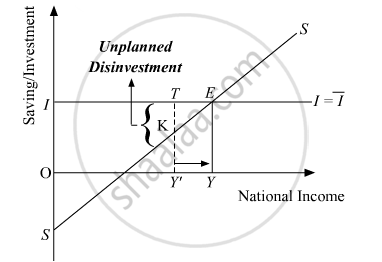Advertisements
Advertisements
Question
Discuss the adjustment mechanism in the following situation :
Ex-Ante Investments are greater than Ex-Ante Savings.
Solution
Ex-Ante Investments are greater than Ex-Ante Savings:
The situation when Ex-ante investment (I) exceeds Ex-Ante saving (S) i.e. when injections into the circular flow of income is greater than withdrawal from the income, then it implies that total consumption expenditure is greater than what is required to purchase the available supply of goods and services. In other words, we can understand this as low saving implies high consumption, which means that the required output is more than the planned output. Thus, there will be unplanned depletion of inventory (or unplanned dis-investment). In response to this, to increase the stock of output, the producers plan to expand production in the next period; thereby increase the employment of factors of production. The increased employment leads to rise in aggregate income in the economy, consequently, higher aggregate saving. The saving will continue to rise, until, it becomes equal to the investment. At a point, where saving and investment are equal, equilibrium is achieved. This process of the adjustment mechanism is explained below graphically.

In the figure, S and I represent the Saving and Investment curves. Let us suppose that the equilibrium is facing a situation, where investment (TY´) exceeds saving (KY´). Consequently, the aggregate consumption expenditure is higher than what is required to buy all the goods and services. Therefore, there exists unplanned depletion of inventory or unplanned dis-investment by TK (i.e. TY´ – KY´) and the producers respond by increasing the production by hiring more factors of production. Consequently, employment increases, and the income of the factors (of the people) rise. Subsequently, the saving rises due to increased income. Hence, the saving will continue to rise, until, saving equates investment at point E. The economy achieves equilibrium at point E, with saving equal to investment and OY level of national income (or output).
APPEARS IN
RELATED QUESTIONS
Given the following data, find the missing values of 'Private Final Consumption Expenditure' and 'Operating Surplus'.
| S.No. | Particulars | Amount (In ₹ crores) |
| (i) | National Income | 50,000 |
| (ii) | Net Indirect Taxes | 1,000 |
| (iii) | Private Final Consumption Expenditure | ? |
| (iv) | Gross Domestic Capital Formation | 17,000 |
| (v) | Profits | 1,000 |
| (vi) | Government Final Consumption Expenditure | 12,500 |
| (vii) | Wages & Salaries | 20,000 |
| (viii) | Consumption of Fixed Capital | 700 |
| (ix) | Mixed Income of Self Employed | 13,000 |
| (x) | Operating Surplus | ? |
| (xi) | Net Factor Income from Abroad | 500 |
| (xii) | Net Exports | 2,000 |
According to Keynes, investment implies ______
With the increase in investment, MEC ______
Which of the following is a Read Investment?
Under Keynesian framework income is measured along ______.
Keynesian economics came to be widely accepted because it finds solution to ______.
In the Keynesian model of income determination, consumer expenditure includes spending by ______.
If MPC = 0.5 and the initial investment is 100 Rs crores, the income generated in the economy will be ______
When an economy they’re to save all its extra income then investment calculation will be ______
______ refers to the planned or intended investment during a particular period of time.
______ refers to the actual level of investment during a particular period of time.
Which of the following statements is correct?
What happens when the Investment is lesser than Savings?
Investment Multiplier is the ratio of change in ______ and ______
Assertion (A): Ex-post Investments represent planned Investments; whereas ex-ante Investments represent actual level of investments.
Reason (R): At equilibrium level, Ex-ante Savings and Ex-ante Investments are always equal.
If an economy plans to increase its income by ₹ 2,000 crore and the Marginal Propensity to Consume is 75%. Estimate the increase in investment required to achieve the targeted increase in income.
